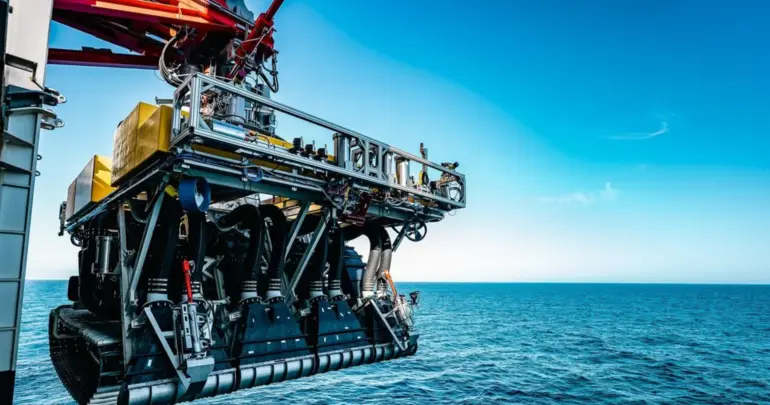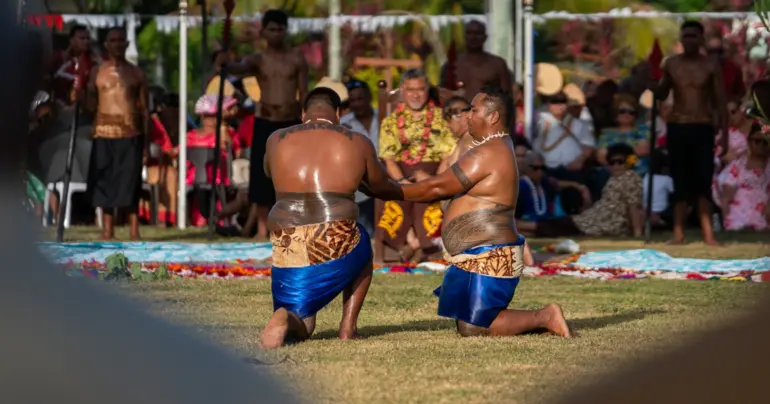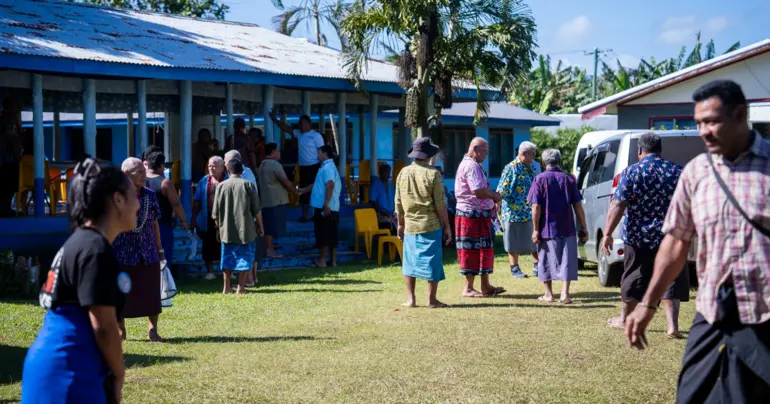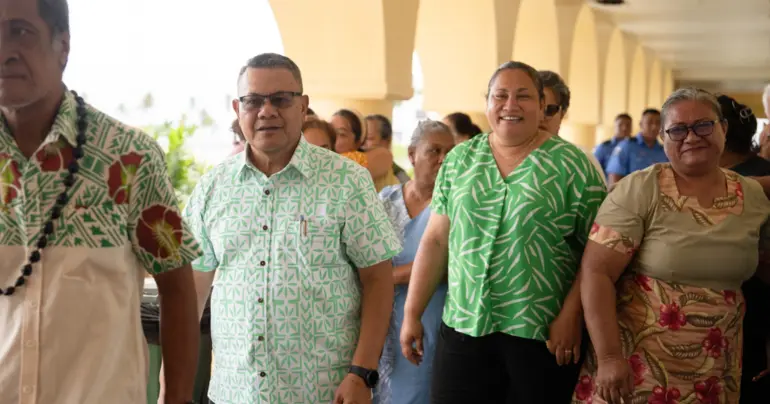Waking the sleeping giant
An ancient stone mound was reawakened on Thursday in a ceremony attended by close to 100 people. The sounds of prehistoric Samoa were befittingly featured in the re-emergence of the massive stone structure into the consciousness of modern Samoans.
The foafoa (conch shell trumpet) has a historical significance as a signalling instrument that stretches back to a time even before the stone mounds were built by the ancients. It is used to announce curfews, signal prayer times, and herald the dawn of a new day. The call of the foafoa carries over long distances, making it a vital tool for communication and the gathering together of people. Often associated with spiritual and ceremonial practices, the much-revered foafoa opened the ceremony in Sa‘anapu. A brief ‘ava ceremony, the traditional ritual of welcome that marks important occasions, was followed by the singing of the song “Amuia le Lupe.” The powerful voices of three young women from the Tuigaleava family echoed in the surrounding forest. The site is customarily held in trust by the Tuigaleava family and is known as Si‘ua‘i.
Reflecting on the significance of the opening of the tia, a Maori proverb shared by Matthew Scadden, Second Secretary, Political, NZ High Commission, at an event held earlier in the week and organized by the Museum of Samoa to mark International Museum Day, seemed totally apt to Galumalemana Steven Percival who managed the project leading up to the opening: “Kia whakatōmuri te haere whakamua: I walk backwards into the future with my eyes fixed on my past.” This is because the project has used the latest technologies to digitally activate the ancient site.
“The work we undertook could not have been done without the support of the ACP-EU Programme Enhancing capacity for the sustainability of the cultural and creative industries in the Pacific,” stated Galumalemana. The project, “Living Monuments: Exploring Samoa's Heritage Through virtual space,” follows on from an earlier initiative titled Rock-Paper-Scissors, which explored the stone tools of Samoa, pottery, and the making of fibre-based paper. For “Living Monuments,” attention shifted to this ancient stone structure, one of hundreds that dot Samoa’s heritage landscape.
In her opening remarks, Her Excellency Ms Si'alei Van Toor, New Zealand High Commissioner, stated that New Zealand is proud to be the main development partner in the tourism industry in Samoa. “We are just at the beginning of designing a new phase,” she said, “and over the many years we have been involved with the tourism sector here we have come across several cultural heritage sites, both in Upolu and Savaii, that we would like to be seen to develop further and it is for this reason that I am so pleased to be here today at the opening of the Tia here at Sa’anapu.”
In her statement. Lealaisalanoa Frances Brown-Reupena, Ministry of Natural Resources and Environment, referred to the Tia Seulupe at Sa‘anapu, as a site of deep cultural resonance and now a symbol of our collective commitment to preserving and celebrating our Samoan heritage in both physical and virtual spaces. “This event, I believe, is not just an opening or launching of another monument,” she added, “it is about opening a new chapter in our journey, one that began decades ago, rooted in a national vision to safeguard the natural and cultural legacy of our islands. As early as 1993, Samoa identified heritage preservation as a national priority under our National Environmental Strategy.
By the year 2000, significant progress had been made and Samoa, through the Ministry of Natural Resources and Environment and the Ministry of Education, Sports and Culture as it was known then, conducted national inventories of colonial buildings, ecosystems and sites rich in folklore, supported by UNESCO, towards the development of Samoa’s Tentative List. In 2001, Samoa ratified the World Heritage Convention, affirming our commitment on the global stage. While Samoa has yet to finalise its Tentative List under the World Heritage Convention, today’s event marks a significant milestone for our collective efforts. To the MNRE, to the Government, it represents a revival and reinvigoration of national efforts to safeguard our natural and cultural treasures in a truly holistic manner, honouring the vision that we committed to when we ratified the Convention in 2001. As the Ministry moves towards finalising its Environmental Management and Conservation Bill, it has taken crucial steps to establish a solid legal foundation for the protection of our natural and cultural heritage.
This includes advancing the development of a national list of heritage sites, an essential step toward the eventual finalisation of Samoa’s Tentative List under the World Heritage Convention. The government also reiterates that at the core of these efforts has always been and always will be community engagement and leadership. The Government recognises that heritage preservation must be driven by knowledge, traditions, and voices of our people, especially the traditional owners of the land.”
Speaking on behalf of the Pacific Community was Dr. Frances Vaka‘uta, Team Leader for Culture for Development Division, the implementing agency for the ACP-EU Cultural and Creative Industries grants scheme. “Sites like this one are a testimony to the creativity, the innovation, the spirituality, and our rich cultural heritage in the Pacific. Unfortunately, because of the impact of colonialism and discontinued cultural practices, many of these stories are now only captured in libraries that exist in Europe. And so that makes these sites so important because these stories remain in the living memory of our elders and we need these sites to teach our children to appreciate these stories, to take themselves away from their devices and sit with the elders to listen again before they are gone.
These structures are sites of such immense intangible cultural heritage and indigenous knowledge. In the Pacific, the most significant challenge we face is the fact that we don’t have strong enough legislation and policies to protect our indigenous knowledge. What that means is that we continue to be exploited by others who come from the outside and take this knowledge and profit from it. And so documenting and ensuring community ownership is central to the work that we do. These mounds as many of you will know hold such significant archaeological and cultural memory and by protecting them and making them accessible, we not only honour the ancient wisdom and technology of the ancestors who came before us, but we also ensure that our future generations can learn from, connect with, and be inspired by them.”
The ceremony at the mound was concluded with participants climbing to the top where the foafoa again announced the event and two slit drums, patē, ancient instruments also used for communication purposes since time immemorial, reverberated through the forest canopy. Another instrument, the fagufagu or nose flute, was played by Galumalemana to symbolise the waking of the tia as fagufagu means to waken.
Mr. Lene Fau, Acting Chief Executive Officer of the Samoa Tourism Authority, spoke on the theme of heritage tourism. “The Tourism Authority,” he said, “is honoured to be a part of today’s launching event with the opening of this heritage site. We fully endorse this development as it contributes to our efforts to improve sustainable tourism. Many have known tourism to be an economic driver for Samoa’s development. However, we want to emphasise that tourism is more than that. It is also about environmental stewardship and biodiversity conservation through eco-tourism, community well-being, identity preservation through cultural tourism, such as our heritage site here, all of which contribute to boosting local employment and correlated skill sets within local communities.
Our vision is not only to invest in a sustainable economy but also to ensure that the tourism industry is expanded to diverse areas that can drive our local communities. Our culture makes us unique in the world. It separates us from modern developments you may see on the Internet. We have to protect our identity and culture from being modernised, and we can do this through the lens of tourism, which includes the local economy, social well-being, and environmental conservation. Let this site be a reminder to us all about the countless tourism opportunities we can invest in. Let it be a symbol of our fight to preserve our lands, culture and heritage. Let it be hope for the safeguarding of our unique islands, the fight against climate change impacts.











